Purpose:
The Addressable Automatic Fire Detection and Automated Voice Alarm System is a critical communication infrastructure in multistoried buildings during fire emergencies. It aims to detect fire and smoke, automatically alert occupants to take appropriate actions for their safety and property protection, and facilitate communication between occupants and rescue support staff.
System Overview and Components:
The system consists of main components such as smoke and heat sensors, manual call points, speakers, beacon lights, and the Control Panel. These components are connected using a 2-core cable. The Control Panel is located in the ground floor control room, while strategically positioned speakers and detection devices enable effective fire detection and communication throughout the building.
Statutory Compliance:
Installing the Addressable Automatic Fire Detection and Automated Voice Alarm System is mandatory as per the National Building Code (NBC) 2016, specifically under Part 4, Clause 4.9 C.
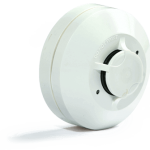
Multisensor Detector:
This device intended to be used for addressable automatic fire detection system to detect presence of smoke, smoke density and abnormal temperature for fire alarm. This combined function of smoke and heat sensor (Multisensor detector) detects abnormal level smoke & heat and raises an alarm which continuously interacts with control panel to update the real time smoke and temperature exists at reported location. This sensor measures the smoke/temperature level in protected areas and analyses the level of smoke/temperature and verify with alarm level setting. When smoke/temperature level crosses the set level, it communicates to fire warning system control panel along with its ID. This smoke sensor works on photoelectric principle. It consists of special LED to illuminate the smoke chamber. This LED illumination level gets reduced due to its aging. Hence its sensitivity may go out of sensitivity range. Therefore it requires a periodical calibration to ensure its functional objective. Refer IS 2189 for more details.

Smoke Detector:
Smoke detectors are employed to detect the presence of smoke and automatically trigger the fire alarm system. The latest generation of smoke sensors can detect smoke density as low as 0.1% obs/ft, providing real-time smoke density information.
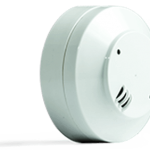
Heat Detector:
Heat detectors are used to identify abnormal heat or rapid temperature rise and automatically trigger the fire alarm system. The latest generation heat detectors provide real-time temperature information.
Real-Time Smoke and Temperature Information:
Real-time capability helps limit alarm activations to fire monitoring staff if conditions are not severe, but it can trigger alarms to occupants if necessary. This flexible setting allows for preliminary stage alarms and main alarms.
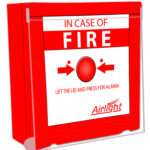
Manual Call Point:
The Manual Call Point is a device used to manually activate the fire alarm system in case of emergency.
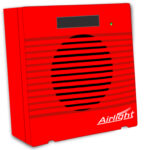
Speaker with Beacon:
Speakers with Beacons are used for automated voice alarms, indicating the location of fire detection. They can also make announcements manually for public address purposes. The beacon helps hearing-impaired occupants understand the fire alarm
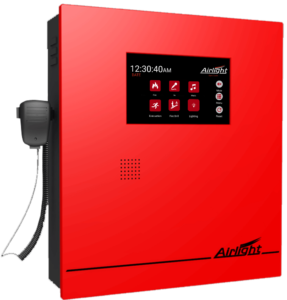
Airlight offers Control Panel For Addressable Automatic Fire Detection And Voice Alarm, Public Address, Lighting, Fire Drill and Evacuation System :
The Airlight control panel is designed for comprehensive control and monitoring of fire detection systems and associated components, simplifying operational tasks and maintenance. It includes Addressable Fire Detection, Public Address, Voice Alarm Messaging, Lighting, Fire Drill, and Fire Evacuation functionalities through an interactive touchscreen display. This unified system operates on a standardized 2-wire, loop-powered setup, ensuring consistent and efficient monitoring of devices for swift intervention.
If someone spots a fire, they can press a button to activate a voice alarm that specifies the fire’s location.
Automatic fire detectors sense smoke and heat, triggering voice alarms when a fire is detected. The Airlight control panel coordinates various automated responses, such as activating speakers and lighting, relaying important voice messages, and potentially deactivating Access Control and HVAC systems.
The control panel continuously updates smoke density and temperature data from field sensors, displaying it on the front panel for real-time assessment. Additionally, the Airlight control panel offers manual control, allowing operators to manage PA speakers, Talkback speakers, and lights individually through separate pages and dedicated icons for ease of use.
1. *Fire Alarm Activation:* Upon detecting a fire from any device, the control panel promptly broadcasts a voice alarm message, specifying the fire’s location. This empowers occupants and rescue personnel to respond quickly, reducing reliance on the control room operator.
2. *Fire Drill Functionality:* Dedicated pages with control icons make it easy to activate fire drills. By selecting the relevant zone icon, the corresponding zone’s speakers engage, delivering appropriate voice instructions to occupants.
3. *Fire Evacuation Support:* Similarly, for fire evacuations, distinct pages with control icons are available. By selecting the appropriate zone icon, the corresponding zone’s speakers are activated, delivering relevant voice instructions to occupants.
4. *Efficient Integration:* The control panel seamlessly integrates information from fire alarm indications, displaying device and zone locations alongside standard additional messages. This eliminates the need for pre-recording voice files.
5. *Customized Messaging:* To facilitate fire drills and evacuations, users can prepare customized statements for each zone and upload them. The control panel automatically incorporates these statements based on the required zone, converting them into voice messages for delivery.
Airlight’s Addressable Public Address System offers precise announcements with unique speaker addresses. The control panel features a handheld microphone and touchscreen display. For location-specific announcements, a dedicated page within the control panel displays control icons for each speaker. This allows users to efficiently deliver targeted messages by selecting the corresponding icon for their desired location, accommodating both zonal and comprehensive announcements.
Airlight’s Automatic Fire Emergency Lighting system provides a reliable backup when primary power sources are compromised due to fires or critical incidents. Each light is uniquely addressed and operates via a loop-powered system, ensuring precise control. These lights can be configured to activate automatically in response to fire alarm triggers. Customization options accommodate site-specific needs, including fire zones and designated escape routes.
Furthermore, the control panel features a dedicated lighting control page, empowering users to activate individual lights, lights within specific zones, or all lights seamlessly. This enhances adaptability and ease of use during emergency situations.
Fire drills are essential for acquainting both operators and occupants with the intricacies of the fire safety system. To serve this purpose effectively, a dedicated page has been crafted exclusively for conducting fire drills. This unique page empowers users to activate it, subsequently providing the capability to trigger specific zones or floors for the drill.
Customizable standard voice instructions can be configured, fine-tuned to the specific target zones. This feature ensures that when a fire drill is initiated for particular target zones, the occupants in other zones can continue undisturbed, enabling focused and efficient training scenarios.
For a well-organized evacuation during fire emergencies, the control panel provides a separate page with easy-to-use zone icons. You have the flexibility to customize standard voice instructions tailored to each specific zone, making them just right. This means that when you initiate a fire evacuation for certain zones, individuals in other areas can carry on without disruptions, ensuring a focused and seamless evacuation .
The system includes a dedicated music page, optimizing its utility for users. This page allows users to easily select their preferred zones, specific speakers, or even choose an “All On” option.
Across various industries, diverse voice statements are crucial for different operational requirements. Whether it’s a collection of statements, background music choices, or even audio from platforms like YouTube, users have the freedom to play their desired content.
An added advantage of this feature is its contribution to the system’s consistent functionality and the longevity of the speakers. Regular use helps uphold their performance over time.
Airlight’s integration capabilities extend beyond its manufacturing range of fire detectors. Devices like beam detectors, flame detectors, aspiration-type smoke detectors, carbon monoxide detectors, and others can effortlessly link to the system through the loop power interface unit, expanding your detection options.
In scenarios where wiring isn’t feasible in certain areas of the building, Airlight provides wireless alternatives.
This control panel has the capability to integrate Airlight wireless devices, including wireless smoke and heat detectors, Manual Call Points (MCPs), as well as control and monitor modules. These devices operate on a 433 MHz radio frequency.
Fire doors primarily serve as critical fire exits. These doors are effectively monitored using a dedicated door monitor device, all integrated into the same fire alarm cable. These doors are crucial during fire emergencies, as they provide an escape route, but they can also be misused. Whenever a fire door is opened, the door monitor device immediately triggers an alarm. To achieve this level of door monitoring, addressable Fire Door Monitors are employed. These specialized devices incorporate magnetic contacts and monitoring units for accurate and reliable monitoring of fire door status.
Elevators are vital components of building infrastructure and demand integration with fire detection and warning systems. Airlight offers an inclusive solution comprising emergency talkback speakers and smoke detectors inside elevator cars and elevator rooms. In the event of a fire or emergency, occupants within the elevator can activate alarms, establish communication with the control panel for assistance and rescue, and, in cases of fire, initiate the command to bring the elevator to the ground floor. This is especially crucial in large, complex buildings with multiple elevators, including designated fire lifts. Elevator areas and floor landings require special consideration as they are critical zones during fire emergencies, ensuring organized evacuation of occupants in a safe and efficient manner.
In an automatic fire detection and alarm system, the role of automatic smoke detection is paramount.
Traditional smoke detectors trigger an alarm as soon as they detect smoke, leading to a series of actions until the system is reset. However, Airlight’s fire panel takes a more discerning approach. When it detects the presence of smoke, it initiates a pre-alarm limited to the control panel. The control panel indicates the location of the detected smoke and the existing smoke density. Fire alarm monitoring staff can then take appropriate action based on variations in smoke levels. If the smoke level diminishes, the control panel ceases the pre-alarm.
If smoke persists continuously for more than 30 seconds or as per the pre-alarm delay setting, it triggers the main alarm, restricted to the locations where smoke is detected. This alerts occupants to confirm the situation through talkback speakers or manual call points. If the smoke dissipates, the control panel automatically stops the alarm and returns to normal.
Furthermore, various temporary situations, such as activities like rituals, welding maintenance work, or dust cleaning, can temporarily introduce smoke. Airlight’s fire panel adeptly manages these types of false alarms.
Dust contamination in smoke detector chambers due to air pollution is another concern. Maintenance service providers can monitor dust accumulation levels from the control panel display to schedule cleaning and maintenance. If unnoticed, the detector automatically triggers a faulty alarm, specifying the detector’s location for prompt action.
Airlight’s fire panel employs a special algorithm to differentiate between dust and smoke, significantly reducing false alarms caused by dust. These features collectively enhance reliability, maintain system integrity, and prevent unnecessary business interruptions.
This automatic false alarm management fosters trust among users and ensures uninterrupted business operations.
Centralized HVAC systems are commonly employed in various buildings. These systems circulate air from the AHU (Air Handling Unit) plant room to different rooms through forward and return air ducts. However, in the event of a fire within a room, elevated heat levels can generate flammable vapors or gases from existing materials. These vapors can then spread through the HVAC ducts to other areas, potentially igniting fires elsewhere. Fires also produce smoke, which can be dispersed through the HVAC duct system, affecting other locations.
Airlight addresses this concern by offering duct type smoke detectors and flammable vapor detectors designed to monitor smoke and flammable gases within the HVAC duct system. Upon detecting a fire within an HVAC duct, these detectors promptly trigger alarms, transmitting their respective locations to the control panel for immediate action.
Additionally, Airlight provides an HVAC fire damper control and monitoring unit. This device not only activates the fire damper solenoid coil but also monitors the closed position of the fire damper. In the event of fire detection within an HVAC duct or rooms connected to it, the control panel can be configured to automatically trigger the respective fire dampers while keeping other locations undisturbed.
A dedicated HVAC monitoring page is integrated into the Airlight control panel, allowing users to monitor the status of fire dampers and exercise manual control. To prevent inadvertent activation during testing and maintenance, the damper controls can be deactivated both automatically and manually. This ensures that the HVAC system remains functional and secure at all times.
According to the National Building Code (NBC), fire pump rooms and their equipment should be monitored from the fire alarm control room.
Airlight offers a specially designed control and monitoring unit tailored for fire pump houses.
The fire pump house is equipped with talkback speaker facilities connecting it to the control room, ensuring effective communication during emergencies. Additionally, emergency lighting is provided for the pump room.
This loop-powered addressable monitoring unit serves to monitor several critical parameters
1. Jockey pump status (ON/OFF)
2. Main hydrant pump status (ON)
3. Main sprinkler pump status (ON)
4. Diesel pump status (ON)
5. Sump water level
6. Diesel fuel level
7. Diesel engine battery condition
8. Main hydrant header pressure
9. Main sprinkler header pressure
10. Jockey pump failure to start
11. Main hydrant pump failure to start
12. Main sprinkler pump failure to start
13. Diesel engine pump failure to start.
This comprehensive monitoring unit ensures the efficient operation of the fire pump house, enhancing safety and reliability during fire emergencies.
In situations where devices may experience failure leading to excessive current draw or cables might undergo short circuits, it’s essential to have safeguards in place. Overcurrent detectors and line isolators serve as effective solutions for addressing these issues across various branches of a system.
In the event of an overcurrent occurrence, these protective components automatically identify and isolate the faulty line. Additionally, they relay this information to the control panel, specifying the location of the issue. This proactive communication enables the control panel to take prompt corrective actions, ensuring that all other circuits and connected devices continue to operate seamlessly without disruptions.
Moreover, this versatile device can also be employed for the manual isolation of specific circuit branches, facilitating maintenance procedures as needed.
The control panel automatically records all fire and fault events, as well as clearing events, along with their respective dates and times. Users can access this valuable data for a wide range of monitoring and investigative purposes.
The control panel offers multi-level password protection to safeguard against unauthorized access and misuse of settings.
The system operates on a 24-volt DC power . Users have the option to utilize an external 24-volt DC power supply. Additionally, we offer a separate power unit that can be provided as needed to fulfill specific power demands.
In scenarios involving distant speakers and lights, higher power consumption might be necessary. Drawing power directly from the control panel could lead to voltage drops and power loss. To address such situations, a loop-powered and monitored power supply unit with an integrated battery is available to cater to localized power needs.
The control panel is equipped with a standard 110 to 230-volt, 10-ampere Switch-Mode Power Supply (SMPS) unit. This unit includes a built-in battery charger and allocated space to accommodate two 12-volt, 18 ampere-hour Sealed Maintenance-Free (SMF) batteries. Users are responsible for calculating their power requirements and subsequently selecting and positioning the appropriate batteries.
The control panel is equipped with WiFi capability, enabling it to establish communication with a Local Area Network (LAN). Through this feature, users can utilize Repeater panels and a CMS via PC graphics software.
The system provides the ability to establish a connection to the cloud using Firebase. It’s important to be aware that the cloud service provider may apply charges for this service. Moreover, we present a dedicated mobile application for Android devices, enabling multiple users to effectively monitor and control the system. This facilitates system configuration and adjustments by both users and service providers.
Through this setup, users and service providers can engage in remote maintenance, minimizing the need for on-site preventive maintenance. Additionally, the service provider can remotely diagnose and rectify faults, potentially reducing the necessity for on-site fault rectification services.
Within the control panel, you’ll find comprehensive user guides covering operation, maintenance, troubleshooting, rectification, as well as modification and alteration procedures.
Within the control panel, you’ll find a contact list that includes emergency contacts and a roster of service providers, readily available for both emergency situations and routine service requirements.
In the “Drawings Folder,” users have the capability to upload various design documents, including fire alarm layout drawings, cable schedules, system configuration Excel sheets, and the system database. These documents can be easily accessed for viewing and downloaded whenever needed.
Within the “Commercial Folder,” users have the convenience to upload a variety of commercial documents such as purchase orders, work order copies, agreement documents, as well as warranty and service records. These files serve as valuable resources for vendor interactions and transactions
Addressable Capability:
Addressable devices enable precise fire location detection, targeted speaker activation, and control panel indication. This feature ensures efficient and timely distribution of fire warning messages to specific areas, enhancing the voice alarm system’s effectiveness.
Wiring and Short Circuit Isolator:
The system requires 2-core cable for simplified connections between components, with the option for tee joints and tree wiring. A short circuit isolator monitors and detects overcurrent issues, isolating faulty circuits and notifying maintenance personnel for necessary action.

Wireless Input Module
Wireless Input Module:
Receives signals from wireless fire detectors and manual call points, acting as an interface for the control panel.
Bill of Materials above the Scheme
| S.NO | Item Description | Unit | Quantity |
| 1 | Control Panel For Fire Alarm System and Voice Alarm System | No | 1 |
| 2 | Addressable Multisensor | No | 28 |
| 3 | Addressable Manual Call point | No | 7 |
| 4 | Addressable Speaker with Beacon | No | 7 |
| 5 | Addressable Short Circuit Isolator | No | 2 |
| 6 | 2×1.5 sq mm Copper Armoured cable | Mtr | 500 |


